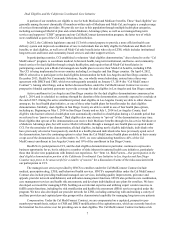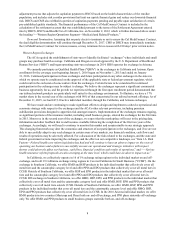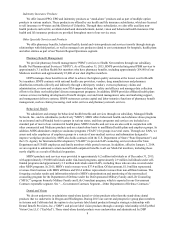Health Net 2015 Annual Report Download - page 19
Download and view the complete annual report
Please find page 19 of the 2015 Health Net annual report below. You can navigate through the pages in the report by either clicking on the pages listed below, or by using the keyword search tool below to find specific information within the annual report.17
• limiting the ability of health plans to vary premiums based on assessments of underlying risk in the
individual and small group markets;
• increasing restrictions on rescinding coverage;
• prohibiting some annual and all lifetime limits on amounts paid on behalf of or to our members;
• limiting the tax-deductible amount of compensation paid to health insurance executives;
• requiring that most individuals obtain health care coverage or pay a penalty, commonly referred to as the
“individual mandate”;
• imposing a sales tax on medical device manufacturers; and
• increasing fees on pharmaceutical manufacturers.
A number of potentially significant provisions of the ACA became effective January 1, 2014, including the health
insurer fee, the operation of qualified health plans ("QHPs") purchased through the exchanges, the premium
stabilization provisions described above, the guaranteed availability requirement, Medicaid expansion and the
individual mandate. However, the schedule for implementation of the provisions of the ACA generally varies from as
early as enactment to as late as 2018. In addition, certain legal and legislative challenges to the ACA remain. For
example, the Consolidated Appropriations Act for fiscal year 2016 (the “2016 Budget Act”), signed into law on
December 18, 2015, delayed or deferred several ACA fees and taxes, including the health insurer fee to be payable in
2017. As a result of the ACA, in many cases, our operational and strategic initiatives have been implemented in
evolving regulatory environments and without the benefit of established market data. In addition, the limited operating
experience in these relatively new marketplaces for insurers and, in certain cases, providers and consumers, has fostered
a dynamic marketplace that requires us to continuously adjust our operating and strategic initiatives over time, and there
is no assurance that insurers, including us, will be able to do so successfully. Any delay or failure by us to execute our
operational and strategic initiatives with respect to health care reform or otherwise appropriately react to the legislation,
implementing regulations, actions of our competitors and the changing marketplace could result in operational
disruptions, disputes with our providers or members, increased exposure to litigation, regulatory issues, damage to our
existing or potential member relationships or other adverse consequences. In addition, if we do not effectively
incorporate the ACA’s premium stabilization and other related provisions into our business, or these provisions are not
successful in mitigating our financial risks, our results of operations may be materially adversely affected.
Due to the magnitude, scope, complexity and remaining uncertainties of the ACA, including the continuing
modification and interpretation of the ACA rules, future regulations and laws implementing the ACA, and the
operational risks involved with simultaneous implementation of multiple initiatives in relatively new markets without
well-established market data, we cannot predict the ACA's ultimate impact on our business. Depending in part on its
ultimate requirements, the ACA could have a material adverse effect on our business, financial condition, cash flows
and results of operations.
For additional discussions of risks and uncertainties related to the ACA, see "Item 1A. Risk Factors."
Other Federal Laws and Regulation
Medicare Legislation and Regulation. Comprehensive legislation, specifically Title XVIII of the Social Security
Act of 1935, as amended, governs our Medicare program. In addition, our Medicare contracts are subject to regulation
by CMS. CMS has the right to audit Medicare contractors and the health care providers and administrative contractors
who provide certain services on their behalf to determine the quality of care being rendered and the degree of
compliance with CMS' contracts and regulations.
See “—Segment Information—Western Region Operations—Medicare Products” for more information on our
Medicare business and see “Item 1A. Risk Factors—Federal and state audits, reviews and investigations of us and our
subsidiaries could have a material adverse effect on our operations, financial condition and cash flows” for a
description of certain regulatory risks associated with our Medicare business.
Medicaid and Related Legislation. Federal law has also implemented other health programs that are partially
funded by the federal government, such as the Medicaid program (known as Medi-Cal in California). Our Medicaid
programs are regulated and administered in California by the DHCS and in Arizona by AHCCCS. Federal funding
remains critical to the viability of these programs. Federal law permits the federal government to oversee and, in some
cases, to enact, regulations and other requirements that must be followed by states with respect to these programs.
























